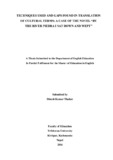Please use this identifier to cite or link to this item:
https://elibrary.tucl.edu.np/handle/123456789/1953| Title: | Techniques Used and Gaps Found In Translation Of Cultural Terms: A Case of the Novel “By The River Piedra I Sat Down and Wept” |
| Authors: | Thakur, Dinesh Kumar |
| Keywords: | English Literature;English Novel;Techniques |
| Issue Date: | 2016 |
| Publisher: | Faculty of Education Tribhuvan University Kirtipur, Kathmandu |
| Abstract: | This research work entitled Techniques Used and Gaps Found in Translation of Cultural Terms: A Case of the Novel “By the River Piedra I Sat Down and Wept” is an attempt to identify and categorize the cultural terms used in the novel “By the River Piedra I Sat Down and Wept”, to find out the techniques employed in translating cultural terms in Nepali version of the same novel and to point out the gaps found in the translation process. I selected 112 cultural terms as sample from original version of the novel using purposive non-random sampling procedure. Observation checklist was used as a tool for data collection. The findings of the study showed that out of total one hundred twelve cultural terms, 43 (38.39%) were related to social culture, 33 (29.46%) were related to organization, customs, activities, 16 (14.29%) were related to ecology. In the same way, it was found that 11 (9.82%) cultural terms were related to material cultures whereas 9 (8.04%) cultural terms were related to gestures and habits. Likewise, it was found that eight different techniques were used to translate cultural terms. They were literal translation, transference/ borrowing, substitution, definition/ paraphrasing, addition, deletion, blending and mistranslation. It was found that literal translation was used mostly i.e. 46(41.07%). Likewise, it was found that there had been linguistic and cultural gaps in the translated version of the novel, e.g. SL term- worker is replaced by TL term kisān and SL term- ritual is replaced by TL term- prakirya which showed linguistic and cultural gap respectively. This thesis is organized into five chapters. The first chapter deals with the background of the study, statement of the problem, objectives of the study, research questions, significance of the study, delimitations of the study and operational definition of the key terms. The second chapter includes review of related theoretical literature, review of related empirical literature, implications of the review for the study and conceptual framework. Similarly, the third chapter includes design and method of the study, population, sample and 10 sampling strategy, study areas/field, data collection tools and techniques, data collection procedures and data analysis and interpretation procedure. Likewise, the fourth chapter presents the analysis and interpretation of results and the fifth chapter included conclusions and recommendations at three different areas (policy related, practice related and further research related) followed by references and appendices. |
| URI: | http://elibrary.tucl.edu.np/handle/123456789/1953 |
| Appears in Collections: | English Language Education |
Items in DSpace are protected by copyright, with all rights reserved, unless otherwise indicated.

